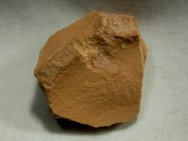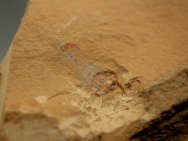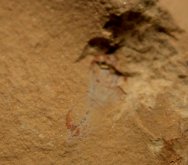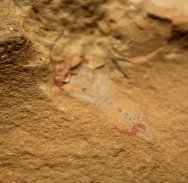Name: Palaeopriapulites
parvus
Phylum
Cephaloryncha or Phylum Priapulida, depending on convention
Geological
Time: Early Cambrian (~525 million years ago)
Size: 7 mm
long by 3 mm across on a 27 mm by 25 mm matrix
Fossil
Site: Maotianshan Shale, Chengjiang Biota,
Quiongzhusi Section, Yu’anshan Member, Heilinpu Formation, Mafang
Village, Anning, Kunming, Yunnan Province, China
| 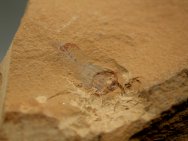 Description:
This is one of the more rare members of the Priapulida is known
as Palaeopriapulites parvus. The diversity of soft-tissue fossils
is astonishing: algae, medusiforms, sponges, priapulids, annelid-like
worms, echinoderms, arthropods (including trilobites), hemichordates,
chordates, and the first agnathan fish make up just a small fraction
of the total. Numerous problematic forms are known as well, some
of which may have represented failed attempts at diversity that
did not persist to the present day. The priapulids are a group of
non-segmented worms whose modern-day examples can reach 30 cm in
length, and live in both shallow and deep marine sands as carnivores.
Individuals of this small taxon (parvus means “small”
in Latin) are less than 10 mm in length with a figure 8 shape. This
is a monotypic genus which has its own family, the Palaeopriapulitidae.
This taxon is only known from the Chengjiang area and Anning. Description:
This is one of the more rare members of the Priapulida is known
as Palaeopriapulites parvus. The diversity of soft-tissue fossils
is astonishing: algae, medusiforms, sponges, priapulids, annelid-like
worms, echinoderms, arthropods (including trilobites), hemichordates,
chordates, and the first agnathan fish make up just a small fraction
of the total. Numerous problematic forms are known as well, some
of which may have represented failed attempts at diversity that
did not persist to the present day. The priapulids are a group of
non-segmented worms whose modern-day examples can reach 30 cm in
length, and live in both shallow and deep marine sands as carnivores.
Individuals of this small taxon (parvus means “small”
in Latin) are less than 10 mm in length with a figure 8 shape. This
is a monotypic genus which has its own family, the Palaeopriapulitidae.
This taxon is only known from the Chengjiang area and Anning.
|
|

